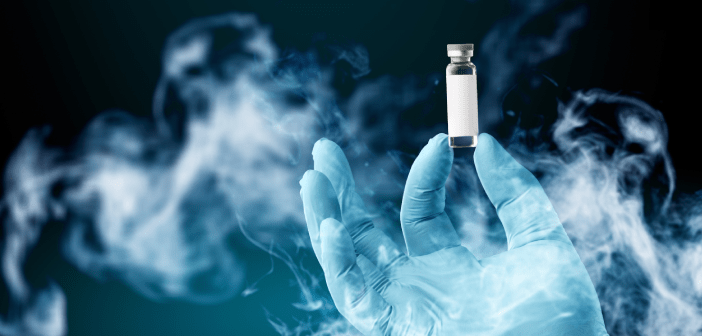Q&A highlights – A chilling impact: cold chain process control in advanced therapies

Understanding the impact and variability cold chain can introduce to your work is critical in executing successful programs. From time and temperature documentation and rigor, to patient-facing service and integrated platforms, a seamless cold chain is critical in maintaining safety and efficacy at scale.
In this webinar, David Lewandowski (Brooks Life Sciences, MA, USA) discusses the challenges and opportunities around considerations for scaling distribution, as well asthe importance of data rigor and process control to improve reproducibility.
Watch the webinar on-demand now or read on for highlights of the Q&A session following David’s presentation.
Will cells be able to be stored at warmer temperatures in the future?
The market would love it, as it would certainly make things easier. Unfortunately, it is not that simple. I have heard comments about looking at cell density and perhaps other mechanisms to allow stability at warmer temperatures – but we’re not there yet. The industry is full of brilliant people who are pushing the limits in bringing therapies to the people who need them.
What is the biggest gap you see in scalability of advanced therapy medicinal products (ATMPs)?
I feel the tech transfer step – taking therapies from the discovery lab to the good manufacturing practice (GMP) setting – is a huge hurdle. There are limited standards to date and even best practice guidance is evolving as we all learn. This raises the question – how do you access GMP-like environments without having to spend or having GMP-like money? We witness groups who believe they ‘have something’ and then they must figure out how to scale the product up and hopefully out to the patients who need it. Coordinating the manufacturing supply chain is difficult as most preclinical and Phase I trials typically only include tens of patients. Most sponsors do not have access to GMP manufacturing and infrastructure, so they partner with CDMOs or academic centers who have GMP space available. Organizations have a strategic decision to make about scale up and when to bring the function in house. Series A and B funding is increasing and allowing more opportunity to incorporate rigor and well-characterized process improvements for these new therapies and cures.
Where else can I go to gain information and education?
Great resources are available. The Alliance for Regenerative Medicine (ARM) has established itself as the leading global voice in cell and gene therapy (CGT). There are many other great organizations helping to drive education and efficiency. Some include ISCT, Standards Coordinating Body, FACT, JACIE, ASTCT, CBER/FDA, NHS to name a few. These are fantastic groups who are forming very collaborative communities and are here to help represent the interest of regenerative medicines and advanced therapies. Do reach out to these advocacy organizations.
Has there been enough research for cryopreservation, especially for CGTs?
There has been some incredible research done to this point. We will see more around cold chain and distribution as we begin to include cryopreservation and thawing in the product characterization steps. In the last approximately 5 years, focus on bioprocessing and analytics were viewed as the essential steps, and much discussion centered here. As product distribution topics come to the forefront, more people are learning about cryopreservation and cold chain.
Watch this webinar on-demand now
Cold chain management, proper storage and other ’out of facility’ handling logistics are a nightmare in low- and middle-income countries (LMIC) – do you have any suggestions on how to overcome these hurdles?
Cost is always a challenge, and obviously infrastructure related to it is a challenge too. While we’re not all set up with vespas, or easy means to access regional areas right now, my hope is that we will see regional centers and regional leaders emerge – some of that work is already happening. The International Society for Biological and Environmental Repositories (ISBER) has been exploring ways to support research related to activities in LMIC. Maybe we can expand and share that knowledge.
What are the top 3 challenges for standardizing cryo cassettes?
- Collaboration first of all – there are many siloed discussions happening. As a result, progress is slower than all stakeholders would like
- Standard cryo cassette sizes
- Enable engineering
- I always think of Society for Biomolecular Screening (SBS) racks
SBS format: in liquid handling and high-throughput screening, standards have been in place for years. Liquid handlers are all about speed, filling 96 wells in 0.5 seconds. It’s incredible what they’re able to do – including managing acoustic droplets (in nanoliters) at high rates.
CGT is not quite there yet. With our own defined form factors, to support cryogenic workflows and distribution, our industry could go faster. Engineering teams could design with confidence. Distribution networks can build the infrastructure to support the future.
The Standards Coordinating Body is working hard on a Parenteral Drug Association (PDA) initiative to support the development of a standard for cryopreservation of cell therapies. I would encourage everyone to participate if they can [1].
Why is it important to understand the ‘glass transition’?
Really good question. Everything under that temperature of -135°C, glass transition (Tg) -190°C or -150°C, all biological processes stop. It’s hard to believe, but even at -80°C or dry ice temperatures, biological processes are slowed, but not stopped.
Processes should be designed with this understanding, to prevent the product from getting above -135°C until it is intended to be thawed.
If you’re interested in learning more about glass transition, do look at our series of whitepapers exploring sample warming, best practice and manual versus automated methods to protect product integrity [2].
[1] Standards Coordinating Body. PDA-led project: cryopreservation of cells.
www.standardscoordinatingbody.org/pda-led-project-cryopreservation-cells
[Accessed 11 June 2021]
[2] Brooks Life Sciences. BioStore™ III Cryo: process control, product integrity.
www.brookslifesciences.com/biostore-iii-cryo-process-control-product-integrity
[Accessed 11 June 2021]